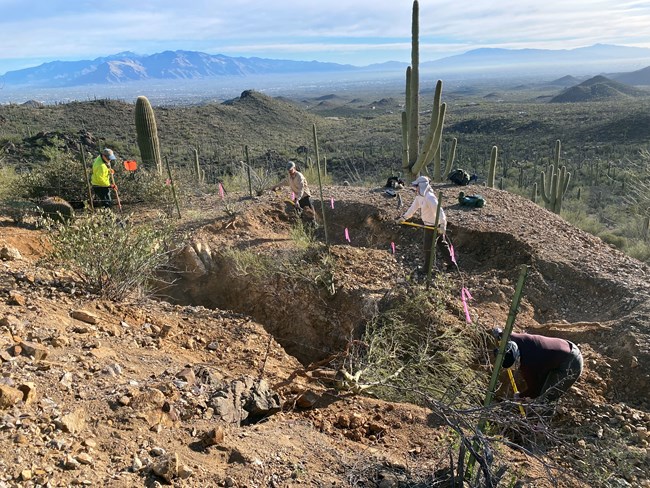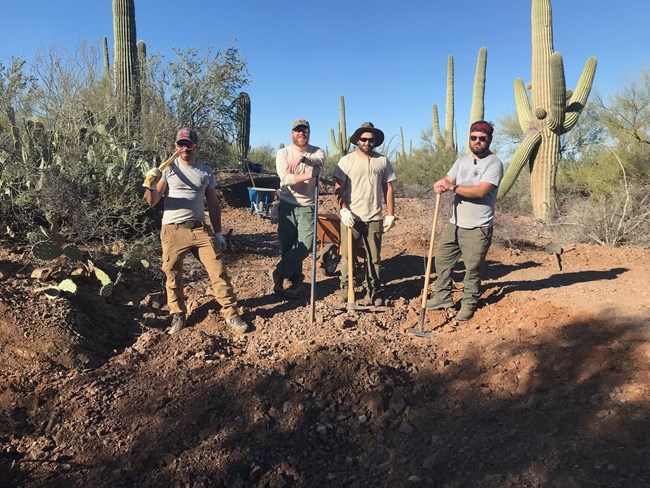Last updated: August 14, 2024
Article
NPS Barricades Abandoned Mines that Pose Danger for Wildlife and Visitors at Saguaro National Park

NPS Photo/ Adam Springer
Native wildlife in Saguaro National Park are being entrapped in abandoned mines scattered throughout the vast wilderness of the park's forest. With funding from the Bipartisan Infrastructure Law, park staff working with the Forest Service will soon close 15 mines to improve safety conditions for wildlife and park visitors and to restore the park landscape.
“We call it mining in reverse,” said Adam Springer, a resource management specialist in the park. “We take the rock that came out of the hole which is usually right nearby and put it back with pick and shovel. That effectively closes the mine that at the start of the project posed significant risk for wildlife.”
It may not sound intuitive to the average person, but park staff prioritize the shallowest holes over deeper mineshafts. First, there are more shallow holes than deep shafts and even a shallow hole is life-threatening to the Sonoran desert tortoise. Springer said, “It doesn’t have to be a deep hole to trap a tortoise that may be 50 years old that spent its final days and weeks scratching at the sides trying to get out. These little creatures are not an endangered species, but they are a species of concern for the National Park Service.”
Like the desert tortoise, not all wildlife can escape a mine on their own. National Park Service staff have also had to rescue a bobcat, which they helped by putting a tree branch down a 20-foot mine for the bobcat to climb out. “We did not know how it would respond so once we placed the branch, we scattered and hid behind trees to give it some space,” Springer said. “It was pretty weak and barely had enough energy to climb out, then he trotted away pretty shakily.”
The first step in the process of closing the mines is to clear the wildlife inhabiting the mines and surrounding areas. The park has experience in the work having closed 157 mines in the park in the past three-and-a-half years before the availability of funds from the Bipartisan Infrastructure Law. Adits which are a horizontal mineshaft, can be a habitat for various species including mountain lions, bobcats, javelinas, bats, ring-tailed cats and snakes. Chicken wire is placed over the mine in a way for wildlife to get out and not want to go back in. A couple of weeks later, crews return and remove any remaining animals.

NPS Photo/ Adam Springer
Horizontal ledges within the mines are also habitat for species like owls that like to perch on the walls. “As soon as you make noise and peek in, they startle and leave,” Springer said. “There is a lot of surrounding not-a-mine habitat for them.”
Crews conduct this work during seasons where it is easier for the wildlife to transition to new habitats. Springer said, “Cooler weather is better for removing bees and snakes since they’re calmer in cooler weather.”
Some of the mine closures have meant dealing with invasive species that affect the native wildlife of the park. “We can’t safely close the mines without getting rid of the bees first,” Springer said. “Africanized bees are non-native and compete with native bees, so we euthanize the well-established hives.”
Funds from the Bipartisan Infrastructure Law helped staff the park and pay for expenses like renting helicopters to transport the steel Forest Service welders will use to create custom mine closure barriers. When materials are staged, about a week’s work, then a three-person welding team will come in to close 15 mines in 10 days.
Helicopters and Forest Service welding crews do draw attention, but the park’s “reverse mining” crew also gets major respect. “Mine shafts can be deep,” Springer said. “Mine 67A is the deepest feature we filled—55 feet deep with a 12 by 12-foot opening. “We worked five 10-hour days with a five-person trail crew. It was day three when we saw the bottom, but we filled it, with pick and shovel.”
Abandoned mineral mines are symbolic of American history—and while they no longer serve the same purpose, they are still attractive to people seeking the mines for various reasons. Miners originally came to Saguaro for copper, lead, and silver, and while gold was found, it was not a primary target. “We do find evidence of people going to these mines frequently,” Springer said. “We find evidence of people rappelling into mines or finding another way to get down in them, which is a public health and safety concern worth mitigating.”
The presence of the mines originally restricted park's forest to be designated wilderness, since the 1970s, 78% of Saguaro National Park is designated wilderness. “We are now removing the mines and improving and preserving the wilderness standards here at the park.” While Saguaro does have deep-rooted history in the mines, there is a balance between both natural and cultural resources. “We are putting steel grates and gates over the mines because they are historically significant and eligible for the National Register of Historic Places,” Springer said. “So, we're trying to preserve that history while eliminating the risk to humans and wildlife.”

NPS Photo/ Luke Hetherington (left, middle), Adam Springer (right)
